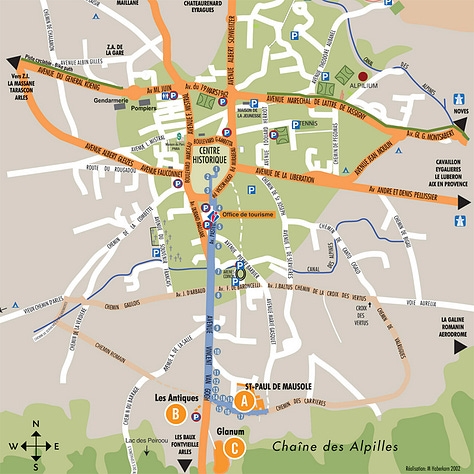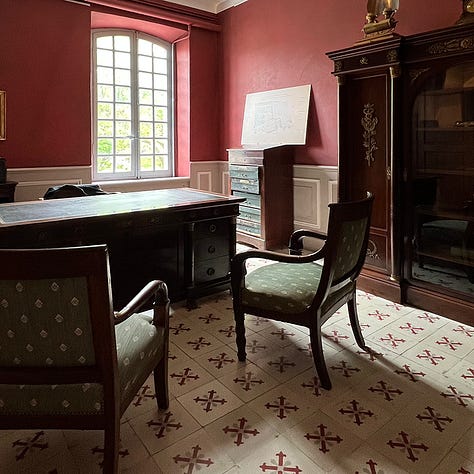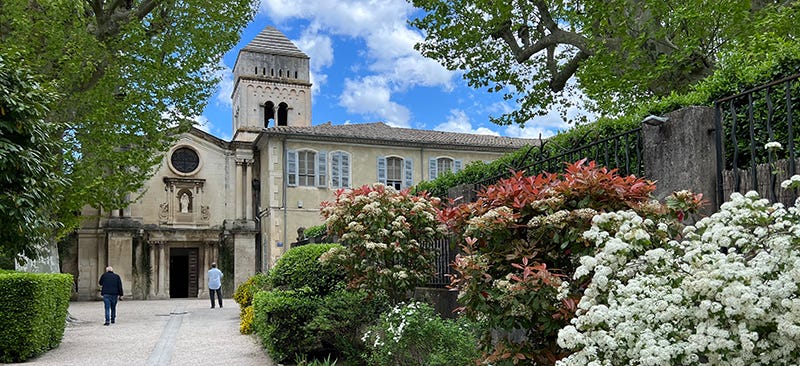The Van Gogh Walk
Stroll a spiritually moving route in Saint-Rémy-de-Provence

It’s late May in Chicago and still cold. Coming from the south of France, already deep in early summer mode … think nightly terrasses, a warm Mediterranean breeze, and an Aperol spritz with friends … makes returning to the chilly Midwest all the more difficult to handle. As I sit at my computer, ever hopeful we’ll break 60 degrees but still in a sweater and thick socks, I’m waxing philosophic over one of the last stops of our recent antiquing trip: The ancient, tiny, and spectacularly beautiful Saint-Rémy-de-Provence.
Why Saint-Rémy, you ask? Its pre-Roman origins? Its history as an intellectual center, the birthplace of Nostradamus? Maybe it’s laid-back Mediterranean ease, or its chic shopping district?
The real reason I’m thinking about Saint-Rémy is for its most famous artist-in-residence: Vincent van Gogh, who lived there between 1889 and 1890. More accurately, he lived in an asylum just outside the city.
Van Gogh left an indelible mark on this jewel of Provence, and the many fans who come to Saint-Rémy pay homage to his legacy through what is known as the Van Gogh Walk. It’s a pilgrimage, really, through the town and landscapes that inspired Van Gogh to paint some of his most famous works.
The Backstory
After a series of mental crises in the city of Arles culminating in the infamous ear cutting, Van Gogh voluntarily committed himself to the Saint Paul de Mausole Asylum just outside Saint-Rémy on 8 May 1889. At the request of his brother Theo, Vincent was granted two adjoining rooms in the asylum, one of which he used as a studio. It was here that, in just one year, he would produce 150 paintings and drawings while under the treatment of the asylum director, Dr. Théophile Peyron. Those 150 works include the masterpieces Sunflowers, Irises, and The Starry Night.
Want to learn more? Read about Van Gogh’s experiences in Arles and Saint-Remy in his own words: The Letters of Vincent van Gogh
By May 1890, believing the once restorative life at the asylum was no longer helping (he suffered periodic attacks, possibly due to epilepsy), Van Gogh left Saint-Rémy for Auvers-sur-Oise near Paris, where, sadly, he took his life just two months later.
Both Saint-Rémy and its sister city, Arles (just 15 miles to the southwest), figure prominently in the painter’s life and oeuvre, and both have historical Van Gogh walks that should be on everyone’s bucket list!
The Walk
The Van Gogh Walk is a free, self-guided tour that takes you from the center of the historic district and out of town, past fields of cypress and olive trees, to the grounds of Saint-Paul, originally a 12th-century Augustinian monastery.
Begin your walk just outside the Musée Estrine, located in the heart of the old town (number 1 in blue on the map).



Bronze markers are embedded in the pavement at regular intervals to guide your way. Along the walk are 19 informational placards: Each featuring a different painting created during Van Gogh’s stay, and facing a vista that may have inspired the work. Excerpts of letters written by the artist further tie the painting to the landscape … and inspire one to consider the deep ties Van Gogh had with his surroundings.
The walk out of town and into the countryside is a wonderful way to unwind and really take in the beauty of Provence. When a warm wind is blowing (as it was when we were there) one sees the connection between flowing grasses, or olive trees with their fulgent leaves, and the sinewy, energetic brushstrokes that characterize Van Gogh’s later work. The artist captured the very essence of movement and light like none other.

Saint-Paul de Mausole
The walk ends one kilometer (a little over one half mile) at the gates of Saint-Paul de Mausole. But the tour isn’t over! Buy a ticket at the gate to visit this stunning monastery-turned-hospital-turned-museum, parts of which are still operational today. The buildings, grounds, and plantings of Saint-Paul are breathtakingly beautiful and exude a deep sense of peace.
The hospital wing that housed Van Gogh has been converted entirely into a museum. Visitors are free to tour its reconstructed kitchens, dining rooms, laundry, treatment areas, and doctor’s offices. Towards the back of the building, past the laundry hall, is a collection of rooms where Van Gogh may have lived.
While there, you are encouraged to take your time, and thankfully there are no docents standing guard to hurry you along. Likewise there are no cordoned off areas or posted signs of any kind telling you not to touch or what to learn.
It’s a powerful experience to physically walk in Van Gogh’s footsteps, to see where he painted, convalesced, where he bathed or spoke with his doctors. The museum itself is reverently quiet … giving the impression that all the characters in the story have only momentarily left, and may return at any moment.







When you’ve taken it all in, exit through the gift shop downstairs and tour the huge gardens at the back of the asylum, where lavender, purple iris, and red poppy fields beautifully frame the 12th-century structure.
At this point the tour is complete! It’s time walk back into town and maybe enjoy one of those Aperol Spritzes I wrote about earlier.
If this experience is on your bucket list, you’ll find it’s a homerun. The self-paced nature of the walk, the surrounding Provence landscape, the authentic plantings … everything about the Van Gogh Walk … is incredibly restorative. We left feeling energized, and with a deeper understanding of the artist and his last years of life.
Happy hunting!
Resources
General Information: Van Gogh Walk
St. Remy Office of Tourism (get your free map!): Click Here
Learn more about Saint Paul de Mausole: Click Here
Learn more about Saint Rémy de Provence: Click Here






Thank you Amy 😘. Glad you enjoyed the article. I’ll look for the NYT piece
I love this so much! Did you happen to see the NYTimes had an art challenge - where they challenged readers to look at Starry Night for a solid 3 minutes? They presented an on-screen, high resolution image of the work that you could zoom in to see the texture, the colors, the up-close details. I really enjoyed it, and I am going to add this walk to my wish list. Thank you for the beautiful article and thoughtful images!